|
Tulips
|
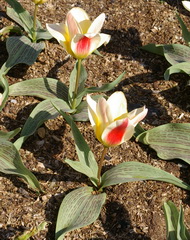
Types of Tulips? Yes there are several categories and they are based on the time of flowering and the type of bloom. Single Early is a very descriptive group as is Double Late. Some of the other’s names, such as Triumph and Darwin hybrids, are less helpful. What you really want to know in order to plan a succession of Tulips in your garden are blooming times and size. My challenge is to give you a quick and understandable overview. The earliest are the actual species such as Gregii, often with red variegated foliage, pictured right,) and Kaufmanniana types and there are several colours to choose from within these and all of the other groups. The added advantage of these varieties is their tendency to become long lived perennials.
Best Value? These are followed in the garden by the aptly named, Single Early and Double Early types. Generally the later in the season that these bulbs bloom the taller they are. The Emperor or Fosteriana are a small group of very important Tulips. They are relatively short, bloom fairly early and have some of the largest flowers available. The added bonus, they are usually quite inexpensive. If you are a beginning bulb gardener, then this is the place to start.
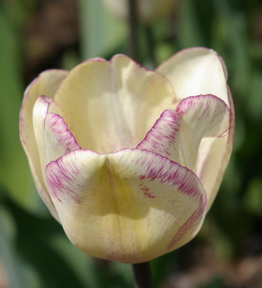 A Little Later. The Triumph Tulips (Shirley, pictured left,)are the large mid-spring group that has a wide range of colourful varieties and grows up to 60cm (24") tall. The Darwin Hybrids are the giants of the Tulip world. They have large flowers on tall strong stems and come in wide range of colours. They are used to make the wonderful mid-season displays and have the added bonus of being good perennials that will last for many years in your garden. There are two late general groups, Single late and Double late that are quite self explanatory.
A Little Later. The Triumph Tulips (Shirley, pictured left,)are the large mid-spring group that has a wide range of colourful varieties and grows up to 60cm (24") tall. The Darwin Hybrids are the giants of the Tulip world. They have large flowers on tall strong stems and come in wide range of colours. They are used to make the wonderful mid-season displays and have the added bonus of being good perennials that will last for many years in your garden. There are two late general groups, Single late and Double late that are quite self explanatory.
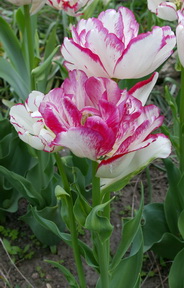
Different Shapes There are a few other categories that are based on the flower form. Most of them are quite late flowering. They include the Parrots that have large recurved petals and are really very interesting. The Lily flowered which have pointed petals and add an elegance to the garden. The Fringed varieties, a self described group and the Bouquet flowered group. These have branching bloom stalks so that there are multiple blooms. The amazing Belicia, (pictured left,) a new favourite of mine is both double and bouquet flowered. Finally there are the Viridifloras that have some green element to the flowers. Not common but quite interesting if you have run out of different types of to add to your collection.
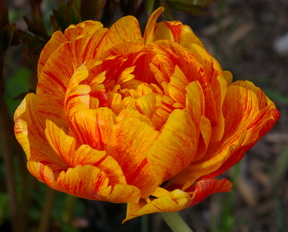 A Little Planning Helps.By choosing an assortment of these various types of Tulips you can have an extended period of bloom in your garden. Pay attention to the height and blooming times, almost always indicated on the package when choosing your bulbs. Pay particular attention if you are planning interesting colour combinations to make sure that the varieties that you are choosing to implement your plan, actually bloom at the same time. The wonderful Double Late, Beauty of Apeldoorn is one that you could build a plan around.
A Little Planning Helps.By choosing an assortment of these various types of Tulips you can have an extended period of bloom in your garden. Pay attention to the height and blooming times, almost always indicated on the package when choosing your bulbs. Pay particular attention if you are planning interesting colour combinations to make sure that the varieties that you are choosing to implement your plan, actually bloom at the same time. The wonderful Double Late, Beauty of Apeldoorn is one that you could build a plan around.
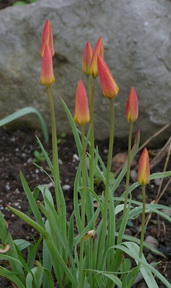
Does Size Matter? In Tulips.Yes! These bulbs are graded by size at the nursery where they are grown and the size of the bulb should be mentioned on the package. 12+ is the largest size and refers to the diameter of the bulb in cm. The larger the bulb the bigger the flowers. When you find packages of inexpensive bulbs check the size to see what you are getting. There are exceptions to this, of course. Some of the species such T. Clusiana Tinka, (pictured left,) are quite small bulbs, 6+ but are great naturalizers. This wonderful flower has yellow inner colour on the petals and opens fully each day to show it and then closes at night to this outer red colour.
Tulip growers refuse to admit the existence of squirrels. If I don’t believe in them they can’t eat my bulbs. Failing that the best cure is to plant them quite deep, 15 -20 cm, (6-8 in) tree rats are lazy and won’t dig very deep. The bulbs will actually perform better from that depth. Leave a few peanuts somewhere else in the garden as a diversion. I’m not sure if that attracts even more tree rats but it’s worth a try.
